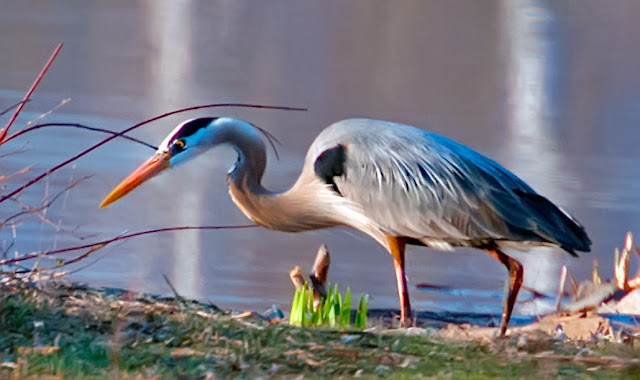After several minutes of peenting the bird finally took to the air. It went up fast and high - a member of the group indicated the flight pattern by the zig-zag motions of his hand. It was too dark by then for me, but we all heard the fluttering song of his wings. I had made a recording a couple of years ago. (If you use the Chrome Browser the sound starts right off and the browser lacks an on-off feature.)
When you listen carefully you'll hear the following sequence: the thin nasal buzzy "peent" call preceded by a barely audible "tuko" sound, the twittering made by the wings during sharp turns, and the vocal chirping during aerial flight which becomes louder as the bird descends. The last part of the descent is silent. Then a soft fluttering of the wings as the bird lands.
I also took some photos of the bird on the ground, rotating in place while peenting.
I also took some photos of the bird on the ground, rotating in place while peenting.
During the last week of April spring had arrived and migration had started. On a recent walk I saw and heard a couple of Blue Gray Gnatcatchers calling to each other across the trail.
The male sports a uni brow which gives it that fierce look.
Also present were Palm Warblers and Myrtles (Eastern Yellow-Rumps)
A pair of Blacks and White Warblers were flitting through the trees, One of them was a male, the other probably an immature bird or a female.
.
After reading Lillian Stokes enthusiastic review of the Canon Powershot SX50SH I had to have it, because its telephoto lens could zoom out from my current 400mm to 1200 mm, a feat that for my Nikon D300 would cost me thousands of dollars, and anyway would be way too heavy to carry. So I sold my Powershot S95 and bought this camera instead. I found out, though, to utilize this power I have to spend hours of practice. At such high power magnification with resulting small field of vision it's impossible to keep track of small birds on their foraging trips through the trees. So for that I went back to my large Nikon.
Maybe I will yet the hang of it, anticipate, move faster... The camera works great for stationary birds, like the juvenile Red-throated Loon below which showed up on a sheltered bay of the CT River, or the Great Blue Heron about the snag his breakfast, or the Eastern Towhee below or the White-throated Sparrow.
Have you noticed when the waiter brings the plates with food to the table, the diners' eyes pop out just like this?
Eastern Towhees were present in large numbers. This one was at Montague Sandplains WMR where, at dusk, I saw a whole flock of around 30 to 40 birds flying overhead east to southwest
The backyard is teeming with White-throated Sparrows. I have been scattering black oil sunflower seeds on the grass to avoid having them all at once sitting gobbled up by grey squirrels.
This White-throated sparrow has unusual bright yellow alula feathers at the shoulders, which I haven't seen on any of the illustrations in my guide books. Alula feathers are often hidden; it's probably a variation, not a hybrid.
Happy Birding!















